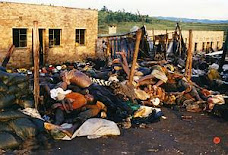by Adam Miller | University of Michigan
And yet Congo is today one of the poorest, most violent, most chaotic places on Earth—without medicine, electricity, law, or order. Heartbreakingly, mass rape is rampant, pandemic, and a tactic of both government forces and militias that control large portions of the nation as a result of a prior brutal civil war and its continuing repercussions.
As an Afro-American and African Studies minor at the University of Michigan, I turn to international news outlets—particularly Al Jazeera and the BBC—for the latest happenings in African countries such as the DRC, as the United States media has proven time and again that, where national interest is not at stake, neither is aid nor coverage.
Having been to Rwanda earlier this summer and to the border with the Congo, I had the opportunity to speak with several individuals for whom this situation is a daily reality and fear. As such, I take it upon myself to attempt to explain a highly complex, highly volatile issue and explain it to my peers, the readers of NextGen Journal, as these issues cannot be solved until there is international pressure. And surely international pressure will not happen if the international community is not informed with the ‘goings-on’ of third-world African nations.
First, then, it is critical to note the legacy of colonialism of the DRC. Congo has been the victim of more than a century of colonial domination and exploitation—first by the Belgians and then by other African nations, including Rwanda, Uganda, and Zimbabwe. In fact, said countries’ idea of peace might be more accurately spelled ‘piece:’ a piece of the pie, or of the DRC’s many minerals like coltan, which is used in cell phones. It is also important to realize that most of the violence in Congo is local—it isn’t really coordinated on a large scale by the state. It is essentially the product of conflict among fragmented local militias, each trying to push their own agendas at the village or district level, and this expands rapidly.
According to Al Jazeera, the conflict ultimately began in neighboring Rwanda with the 1994 genocide. The country essentially became a killing field, with troops from six African nations and approximately five million people dead, killed by war and starvation. Eastern DR Congo has been plagued by fighting since 1994, when more than a million ethnic Hutus crossed the border into DR Congo following the genocide in Rwanda, in which some 800,000 people—mostly Tutsi—died. And Rwanda has twice invaded its much larger neighbor, saying it was trying to take action against Hutu rebels based in DR Congo.
Furthermore, the situation in Congo keeps deteriorating even though its current civil war has officially been over for years and the United Nations’ second-largest peacekeeping mission is based there. The international community has largely failed to help Congo achieve peace because of misinformation and, stemming from that, a fundamental misunderstanding of the causes of the violence there. This civil war has been the deadliest conflict since World War II, and the single largest humanitarian crisis in the world. Babies and elderly grandmothers have been raped, as a weapon of war. It is estimated that some two million people have fled their homes—and about 200,000 since April of this year.
Most recently is what is known as the East Democratic Republic of Congo mutiny, fighting that has gone on in North Kivu (an eastern province) since the formal end of the Second
Just last year, more than 15,000 rapes were committed in the DRC, where peacekeepers are unable to fully protect civilians, a senior United Nations official has said. In addition, of the 5,427 sexual attacks this year, about 70% have been perpetrated by “men in uniform,” according to Abubakar Dungus, a UNFPA spokesman. It is not entirely clear if he meant soldiers or rebels—and in all likelihood, he meant both.
Perhaps most shocking (and not reported) are last year’s findings by the American Journal of Public Health that as many as 1.8 million Congolese women have been raped, in total. And factors such as education, income, and area of residence (rural or urban) neither protected nor put women at greater risk.
How does that go under the radar of the international eye? Where is the outcry? Does the world only react where there is oil at stake? These are questions that must be raised, and I hope you will help me raise them.
This is an extraordinarily complex issue, and I look forward to reactions to the piece. Below is a simplified timeline of events in Congo, hopefully to give the situation some shape and perspective.
- April-June 1994: Genocide of Tutsis in Rwanda
- June 1994: Paul Kagame’s Tutsi rebels take power in Rwanda, Hutu fighters flee into Zaire (DR Congo)
- Rwanda’s army enters eastern Zaire to pursue Hutu fighters
- 1997: Laurent Kabila’s AFDL, backed by Rwanda, takes power in Kinshasa
- 1998: Rwanda accuses Kabila of not acting against Hutu rebels and tries to topple him, sparking five years of conflict
- 2003: War officially ends but Hutu and Tutsi militias continue to clash in eastern DR Congo
- 2008: Tutsi-led CNDP rebels march on North Kivu capital, Goma – 250,000 people flee
- 2009: Rwanda and DR Congo agree to a peace deal and CNDP integrated into Congolese army
- 2012: Mutiny led by former CNDP leader Bosco “Terminator” Ntaganda








No comments:
Post a Comment
Note: only a member of this blog may post a comment.